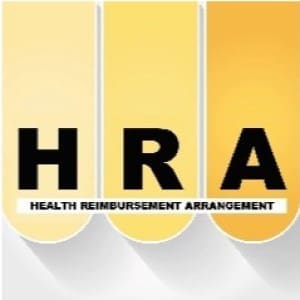What is an HRA?

Does an apple a day keep the doctor away? Only if you have good aim! HA HA HA! But what if you don’t have good aim but still need a doctor? An HRA may be able to help you pay for that service. If you don’t know what an HRA is, keep reading to learn more!
HRA Basics
Health Reimbursement Arrangements (HRAs) are tax-advantaged accounts that help you pay for certain healthcare costs. Employers were first able to offer current and former employees (including retirees) the assistance of an HRA about 20 years ago.
Since then, some rules have changed, and additional, highly specialized HRA versions have been created, including Group Benefit HRAs, Individual Coverage HRAs (ICHRAs), Qualified Small Employer HRAs (QSEHRAs), and Excepted Benefit HRAs (EBHRAs).
Funding
Employers fund HRAs to reimburse employees for eligible expenses. HRA funds are not included in pay, so they don’t affect your income and payroll tax calculations.
Eligible Expenses
Eligible HRA expenses vary based on the type of HRA account and choices made by the employer. For Group Benefit HRAs, qualified healthcare costs typically involve expenses defined by Section 213(d) for diagnosing, treating, mitigating, curing, or preventing diseases and medical conditions affecting any body part.
For ICHRAs, QSEHRAs, and EBHRAs, eligible expenses typically include premiums for qualified individual insurance coverage and specified Section 213(d) expenses at the employer’s discretion.
Employees can refer to their Summary Plan Description (SPD) to learn more about the eligible expenses covered by their HRA. The SPD document should outline all plan terms and conditions for participants and beneficiaries, including the plan start/end dates, qualified expenses, how to submit a claim, etc.
Plan Types
Group Benefit HRA
You must enroll in the group health plan to receive a Group Benefit HRA and reimbursements.
Important Need-To-Knows
- Eligibility/Qualifying – Current employees (and possibly former employees in certain circumstances) may be offered this option. The employer must offer a group health plan, but the plan does not have to satisfy cost-sharing minimums such as those required for HDHPs.
- Contributions – There is no federally mandated limit, but the sponsoring employer must set a contribution limit and a limited timeframe.
- Qualifying Medical Expenses – Employees may submit claims to pay unreimbursed expenses. Employers can restrict eligible expenses, so refer to the SPD for the complete list.
- Unused Balance – Unused funds may roll over depending on the plan setup. Employers who allow rollover may limit the aggregate amount. Unused funds generally revert to the employer if the employee loses qualifying coverage or an employment separation occurs.
Individual Coverage HRA (ICHRA)
Employers offer ICHRAs to help employees purchase individual market health insurance coverage, instead of providing a group health plan.
Important Need-To-Knows
- Eligibility/Qualifying – ICHRAs are available to current employees (and possibly former employees in certain circumstances). Employees must enroll in individual market health coverage that meets Minimum Essential Coverage (MEC) requirements.
- Contributions – There is no federally imposed limit, but employers must set plan limits on reimbursement amount and timeframe. ICHRA funding, terms, and conditions must be the same for all employees within the same class. However, they may vary based on age and family size.
- Qualifying Expenses – ICHRAs reimburse premium costs for qualified individual market health coverage. At the employer’s discretion, they may also reimburse qualified medical expenses. ICHRAs may also reimburse the employee’s dependents enrolled in qualifying individual market health coverage, depending on plan setup.
- Unused Balance – Unused balances may roll over, but employers who allow rollover may limit the aggregate amount. Unused funds generally return to the employer if an employee loses qualifying coverage or an employment separation occurs.
Qualified Small Employer HRA (QSEHRA)
QSEHRAs enable certain small employers to help employees pay premium costs for individual market health insurance policies that meet Minimum Essential Coverage (MEC) guidelines. At the employer’s discretion, QSEHRAs can reimburse qualifying medical expenses under IRS Section 213(d).
Important Need-To-Knows
- Eligibility/Qualifying – Employers can offer QSEHRAs if they have fewer than 50 full-time-equivalent (FTE) employees and do not offer group health coverage. Employees must enroll in either individual or family market coverage that meets MEC requirements to be eligible for premium reimbursement.
- Contributions – QSEHRAs have federally mandated annual reimbursement limits. For 2026, those are $6,450 for employee-only coverage and $13,100 for family coverage. These are maximums, and employers may choose to contribute less. Regardless of the amount, QSEHRAs must be made available to all employees on the same terms. However, amounts can vary based on employee age and family size.
- Qualifying Expenses – QSEHRAs reimburse premiums for qualified health insurance coverage. They may also reimburse qualified medical expenses. Depending on plan setup, QSEHRAs may also compensate for premiums and eligible expenses for the employee’s dependents enrolled in qualified coverage.
- Unused Balance – Unused balances may roll over, although employers may limit the aggregate carryover. Funds carried over count against the following year’s maximum annual limit. Unused funds generally return to the employer if the employee loses qualifying coverage or an employment separation occurs.
Excepted Benefit HRA (EBHRA)
Since 2019, employers of any size have been able to offer an EBHRA, which covers “excepted” benefits only, such as copays, deductibles, and premiums for vision and dental care. EBHRAs can also cover COBRA insurance, long-term care, and short-term care. They must be available to every employee on the same terms if offered.
Important Need-To-Knows
- Eligibility/Qualifying – Current employees (and possibly former employees in certain circumstances) can enroll in EBHRAs. Any employer can offer these accounts to supplement their group health coverage without being constrained by the requirements for integrated HRAs. However, the employee cannot be required to enroll in the group health coverage to receive EBHRA benefits.
- Contributions – EBHRAs have federally mandated annual limits. For 2026, the annual limit is $2,200, but employers may set a lower limit.
- Qualifying Expenses – EBHRAs can reimburse qualified medical expenses under IRS Section 213(d). Like other benefits, employers may restrict eligible expenses. Further, they cannot reimburse premiums for individual health coverage, Medicare, or non-COBRA group health coverage.
- Unused Balance – Unused balances may roll over, although employers may limit the aggregate carryover. Unused funds generally return to the employer if an employee loses their coverage qualification or an employment separation occurs.
Now, go eat an apple! But if you still need to see a doctor, use your HRA funds to pay for eligible expenses. Learn more about these valuable benefit options in my other HRA blogs!
